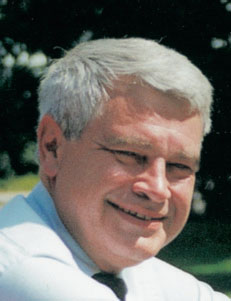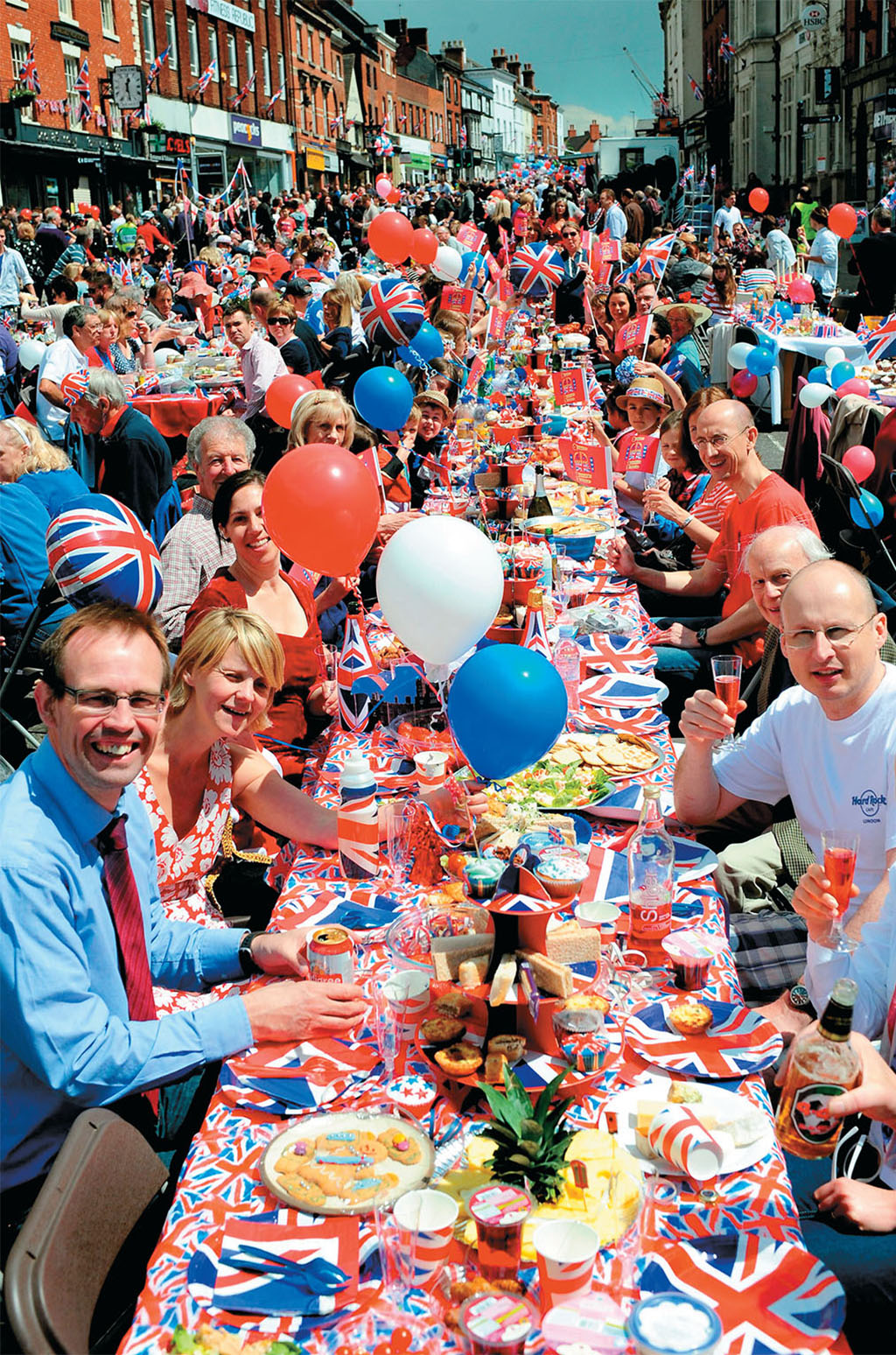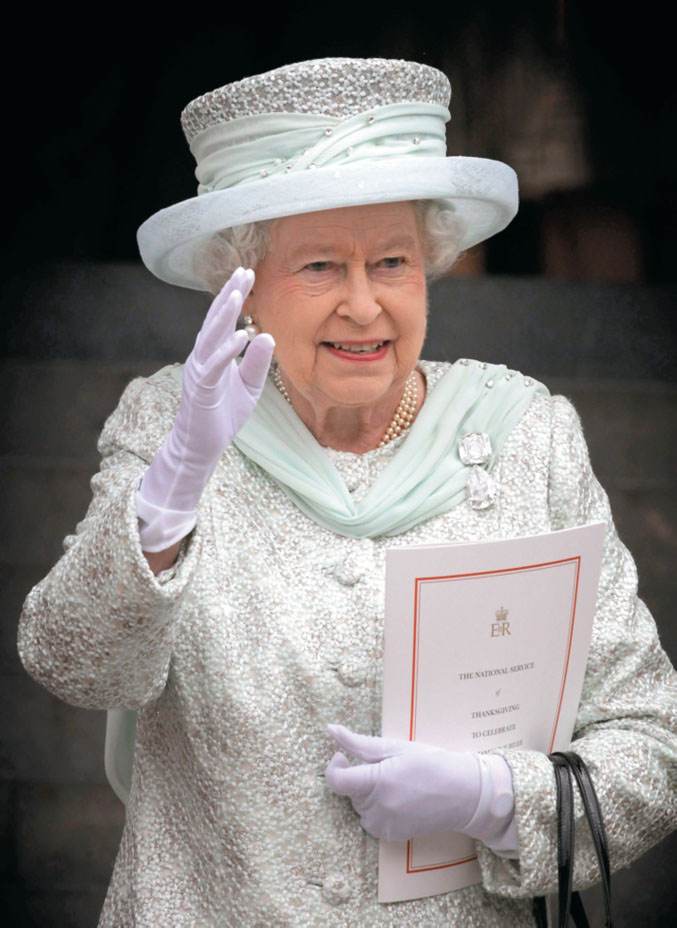
[caption id="GodSavetheQueen_img1" align="aligncenter" width="231"]

[caption id="GodSavetheQueen_img2" align="aligncenter" width="1024"]

RUI VIERA/PAWIRE
CELEBRATIONS OF THE Queen’s Diamond Jubilee will ripple across Britain throughout the year. The big Jubilee weekend itself has come and gone. It was spectacular. The British people have much to be proud of—in their history, in the uniquely British presentation of itself during the long jubilee weekend and in their Queen.
Her Majesty Queen Elizabeth II was the unequivocal star of her own show. Never mind the 60 years of her reign that the occasion celebrated, the grand old queen showed herself made of the sternest of British stuff during the four-day national party. The luster on the Thames Pageant may have been dimmed by the rain, 48-degree temperatures and gray skies. The dismal weather, however, hardly served to dampen the enthusiasm of the million people lining the Thames to watch the 1,000-boat flotilla, however. And throughout, Her Majesty, with Prince Philip at her side, stood in the wet damp for hours.
By the next day, the Duke of Edinburgh was in the hospital. With her 91-year-old husband in the hospital and no time to recover from Sunday’s pageant, the Queen was every bit the attentive, appreciative and gracious lady for Monday’s spectacular Buckingham Palace concert with, again, a million and a half of her friends and neighbors filling the Mall.
With the crowds still thronging, at 10 the next morning Her Majesty was at St. Paul’s Cathedral for a Thanksgiving Service, with all eyes on her yet again. Prince Philip remained hospitalized. After another duly grand reception, the crowds followed her through the streets to fill the Mall again for her appearance with her presumptive successors to the throne on the balcony of Buckingham Palace as a fly-by of historic British aircraft and the Red Arrows soared above.
The sheer physical and emotional stamina of the 86-year-old monarch is astounding. Who else but she could have pulled that off, unmarred by any obvious signs of fatigue or disquiet that her husband was in hospital? Nothing showed but that regal graciousness that has characterized her demeanor through the ups and downs of 60 years of personal and national history as Great Britain’s head of state. In that sense, Elizabeth II certainly does embody the adjective “stately.”
To most American observers, the British monarchy remains something of an enigma. On the one hand, we are instinctively anti-royalist. After all, that’s a good part of what we were contesting on principle with our War of Independence. King George III was the figurehead for all that we objected to in continued governance by Britain. Of course, King George wasn’t really a tyrant. Real political governance in the nation had been effectively ceded to the House of Commons several generations previously. George was largely what the monarch remains today—a constitutional monarch, the head of state, the embodiment of the nation, its national goals, aspirations and ideals. Its front man.
For all that Americans may have inherited an antipathy to the monarchy and hereditary privilege in principle, we have always seemed to adore it in practice. Going back to the 1800s, British royals making it to these shores have been routinely and consistently greeted with rapture and enthusiasm, treated as top shelf, A-list celebrities. And certainly millions of us watched at least parts of the Jubilee events, and cheered for Her Majesty.
That ambivalence is manifest in our odd tacit belief that while a monarch would never be right for America, it is somehow a very good thing for Britain. It works over there, even if we don’t understand why. It was a strange feeling to realize that here I was an American impatient with the republican demonstrators there in the face of that huge royalist political rally. In theory, there’s something wrong with that picture.
[caption id="GodSavetheQueen_img3" align="aligncenter" width="677"]

GETTY IMAGES
Of course, Americans find the institution of the monarchy unfamiliar in part because we do not understand “head of state.” The United States is one of the few nations who unite the offices of head of state and head of government—in the office of the presidency. Most countries separate the roles into a president and premier, or a prime minister and a monarch. Few of the executive functions of government remain seated with modern heads of state. Those big state banquets, ambassadorial receptions and state visits go on, however, no matter who is playing host and hostess.
The advantage of a hereditary monarch in the office of head of state, especially when it proves to be someone as exceptional as Queen Elizabeth II, is that she or he becomes a living personification of national identity and a focal point of national pride. That’s the adulation that Her Majesty accepted from her realm at the Jubilee. She knows enough and is wise enough to accept it with detachment—as something she reflects rather than as something she is due.
Of course, we Americans missed that personification of national identity, so we created one. Uncle Sam wants you. Somehow that just doesn’t have the same ring to it as when the call comes for King and Country.
Yes, there is some quibbling about the expense and the conspicuous consumption of the anniversary year’s expenses and the ongoing cost of the royal institutions. The whole monarchy and all of its dependents cost every British taxpayer about a dollar a year. I’d say the British taxpayer is getting his and her money’s worth—big time.
Kudos to the Brits who got out there to celebrate in London and in street parties and events spread across Great Britain, Northern Ireland and throughout the Commonwealth of nations of which Her Majesty is head of state. Reports of a renewed patriotism across Britain cannot be other than a good thing for the country.
Credit where credit is due, as well—especially after the senseless London riots of last summer. Hundreds of thousands of people descended on the city for the long weekend. Locals, out-of-towners and international visitors strained London’s public transportation infrastructure and engulfed (and drained) the pubs and streets of central London. The crowds were restrained, good-natured and at their British-best behavior throughout. Police reported only 10 arrests over three days, with 1.5 million extra people in the city.
Things will always most certainly go wrong. There’s no glossing over the economically difficult times that still lie ahead for all of us. And a peaceful world remains as elusive now as ever. But something is right with the world. For one glorious, typically soggy, happy weekend in June, Britain celebrated itself and honored its history and one of the most amazing women in the world. Take a bow, Britain.





Comments